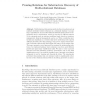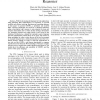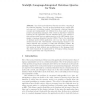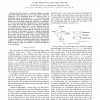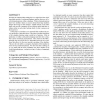PKDD
2007
Springer
14 years 9 months ago
2007
Springer
Multirelational data mining methods discover patterns across multiple interlinked tables (relations) in a relational database. In many large organizations, such a multi-relational ...
CIKM
2007
Springer
14 years 9 months ago
2007
Springer
The rapid growth of available data arises the need for more sophisticated techniques for semantic access to information. It has been proved that using conceptual model or ontology...
ICIW
2008
IEEE
14 years 9 months ago
2008
IEEE
—With the increasing development of real applications using Semantic Web Technologies, it is necessary to provide scalable and efficient ontology querying and reasoning systems....
SLE
2009
Springer
14 years 9 months ago
2009
Springer
One of the most ubiquitous elements of modern computing is the relational database. Very few modern applications are created without some sort of database backend. Unfortunately, r...
SARA
2009
Springer
14 years 9 months ago
2009
Springer
Real-world automated reasoning systems must contend with inconsistencies and the vast amount of information stored in relational databases. In this paper, we introduce compilation...
ESWS
2009
Springer
14 years 9 months ago
2009
Springer
This proposal explores the promotion of existing relational databases to Semantic Web Endpoints. It presents the benefits of ontologybased read and write access to existing relati...
ICDE
2009
IEEE
14 years 10 months ago
2009
IEEE
— Keyword search on relational databases provides users with insights that they can not easily observe using the traditional RDBMS techniques. Here, an l-keyword query is speci�...
WWW
2010
ACM
14 years 10 months ago
2010
ACM
We introduce a client-server toolkit called Sync Kit that demonstrates how client-side database storage can improve the performance of data intensive websites. Sync Kit is designe...
KDD
2009
ACM
15 years 3 months ago
2009
ACM
Research in relational data mining has two major directions: finding global models of a relational database and the discovery of local relational patterns within a database. While...
118
click to vote
ICDE
2006
IEEE
15 years 4 months ago
2006
IEEE
In this paper, we present the ArchIS system that achieves full-functionality transaction-time databases without requiring temporal extensions in XML or database standards. ArchIS&...
